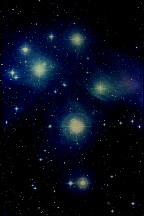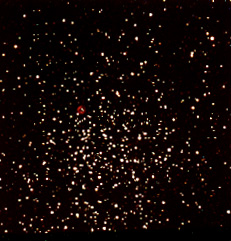
Now that we see the type of environment in which stars are born, lets view some regions which have recently experienced stellar birth. We would expect to see a loose cluster of stars near their birthplace. As time passes, gravitational interactions will tend to cause these loose affiliations to dissipate.
A fine example of such a cluster, called an {\it open} or {\it galactic cluster} is the Pleiades (M45). Also known as the "Seven Sisters" (although you may see dozens of stars in the region through binoculars), this cluster is estimated to be about 20 million years old. Here's a photograph.

[Display "Satellite!"]
Another example of an open cluster is M46 (NGC 2437) in the constellation Puppis. It lies in the plane of the Milky Way galaxy near this point. [Show location.] Here's a photograph.

Go to next section.
Return to "Planetarium Shows This Semester"